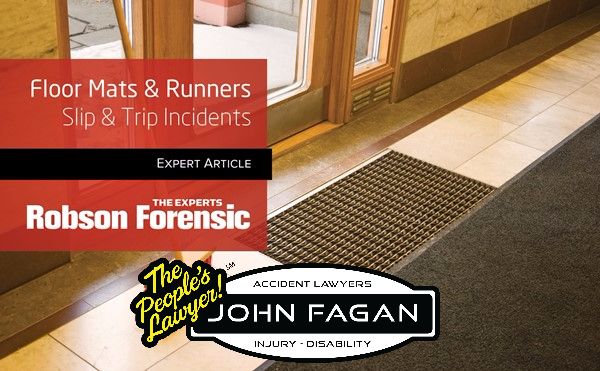ArticleIn this article, architect and retail premises safety expert, Catherine Peterman discusses the appropriate use of floor mats and runners.
When properly selected and maintained, floor mats can be part of an effective program to improve pedestrian safety. However, improper or poorly maintained mats can be hazardous and can cause falls.
FLOOR MATS AND RUNNERS
Floor mats and runners are widely used in retail and commercial environments to improve pedestrian safety in places where water or other contaminants may cause a floor to become dangerously slippery. Their purpose is to remove moisture and soil from the bottom of pedestrian footwear, control the spread of moisture throughout the building interior, and provide a highly slip resistant surface in areas where spills and other sources of moisture are regularly experienced.
Mats and runners can be an effective component of a comprehensive premises safety program; however, they can also pose a dangerous hazard when best practices are not followed. Our experts have investigated many incidents where wrinkled and/or insufficient mat placement has contributed to the cause of a slip/trip and fall.
Definition: Mat vs Runner
Mats and runners serve the same purpose, varying only in their physical dimensions. Both consist of a flat, course piece of material used as a temporary floor covering. A runner is a floor mat that is at least several times longer than it is wide.
Trip Hazards
Aged, worn, and improperly placed mats all have the opportunity to present tripping hazards. Any mat that does not lie flat against the floor without curls, ridges, or puckering has the potential to cause a trip incident. Lightweight mats in particular are susceptible to being torn by handling or excessive wear. Mats that are rolled for storage frequently become misshapen and fail to remain flat while in use.
Safety organizations across many industries have long recognized the potential for tripping hazards and generally recommend that thick mats, made of such materials as coconut fiber or heavy corrugated rubber be used. Where possible, mats should be recessed into the floor to prevent the introduction of a trip hazard. Where recessing is not possible, mats should be constructed with wide, beveled edges, and should be a color that contrasts against the flooring on which it is used.
Slip Hazards
Mats can contribute to, create or become slip hazards in a number of scenarios. When insufficient mats are used such that they fail to remove tracked in soil and water, they fail to be effective in preventing slippery conditions in the areas beyond their reach. A similar condition can exist when mats and runners become saturated with water. Mats and runners can also become slip hazards themselves when they are placed upon a contaminated or slippery surface.
Floor mats of adequate length and width must be properly placed to reduce slip and fall hazards without becoming hazards themselves. The Carpet and Rug Institute recommends that a minimum of 12 to 15 feet of mat coverage be provided to remove 90% of tracked in soil. Mats should abut the door threshold at the entry end and cover the width of the door opening. The National Safety Council warns that mats need to be changed out during the day if they become saturated.
Applicable Standards
Building and fire codes require that floors in a means of egress be reasonably slip resistant and maintained in a safe condition during inclement weather. Several nationally-recognized standards (ANSI/ASTM F1637, ANSI/ASSE 1264.2 and others) describe proper use of floor mats in commercial entryways.
Slip, Trip & Fall Investigations
The Premises Safety experts at Robson Forensic are frequently retained to investigate cases involving slips, trips, and falls as they relate to mats, runners, and other architectural features. Our experts are well versed in the standards relevant to pedestrian safety as well as industry standards governing retail and commercial premises.
For more information visit our Premises Safety practice page
Featured Expert
Catherine Peterman, AIA, NCARB
Architect & Premises Safety Expert
Architect Catherine Peterman is an expert regarding building and premises safety. She has extensive experience in the safe design, renovation and maintenance of retail facilities and other building types. Catherine is an expert regarding building and premises safety, codes and standards, accessibility requirements, analysis of building construction defects and claims, and A/E professional performance.
Catherine Peterman developed this article in concert with other members of the Premises Safety practice group. Please feel free to contact Catherine to discuss your case. She will put you in contact with the appropriate expert for your case.






